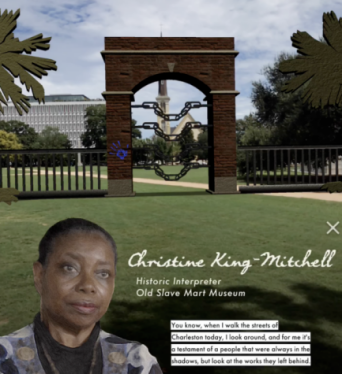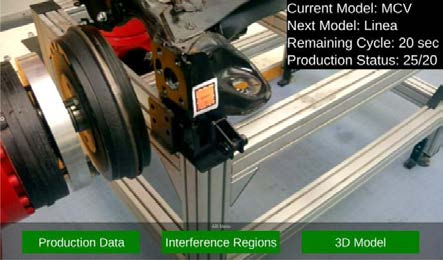1. Introduction
Virtual reality (VR) technology is a computer system that can provide users with an experience of a virtual world [1]. VR technology has three basic characteristics, namely immersion, interaction, and imagination. Immersion refers to the ability of users to immerse themselves in the virtual world while experiencing VR, as if they were in the real world. Interactivity refers to the ability of users to interact with the virtual world through interactive devices. In contrast, conceptualization refers to allowing users to imagine objectively nonexistent environments and broaden human cognition [1].
Augmented Reality (AR) is a technology that combines and interacts the virtual world of a screen with reality. AR supplements the real world with virtual objects, which are computer-generated objects, that appear to coexist in the same space as the real world [2].
Human Computer Interaction (HCI) is a way for users to interact with computers. After years of development, it has evolved from the initial No UI (User Interface) to the command-line era, then to the graphical UI stage, and finally to the natural UI. Specifically, at the beginning of human history, large computers such as Turing machines were used to decipher intelligence, which was very complex and inefficient to operate. Through the development of electronic computers, displays and keyboards have emerged, allowing people to interact with computers by entering command lines. Afterward, graphical user interfaces appeared, such as the Windows operating system, which was mostly window graphic display programs, allowing users to have a more intuitive experience. For natural user interfaces, users only need to interact with machines through the most natural way of human communication.
At present, through VR/AR devices, users can perceive inputs from multiple sensory channels, such as direct voice input, or motion tracking. After reading the collected data, the device can provide users with multisensory channel feedback. That means this VR/AR is also a new HCI interface [1].
2. The practical application of Virtual Reality
2.1. VR in urban cultural creative design
Cities are carriers of culture, and humans live in them. It is crucial to build a comfortable city, but how to ensure the diverse combination of people, places, and the earth while building it, how to ensure people-oriented and reasonable control of urban density, highlight distinctiveness and hierarchy, ensure the layout of open spaces such as parks and squares, and how to arrange design to improve the level of green living facilities, all require designers to conduct in-depth analysis and testing. However, in order to conduct testing and efficiently and quickly design cities, it is necessary to apply VR technology.
VR technology can be applied to the urban culture design industry. Through the powerful simulation environment capability of VR, people can deeply experience its environment and analyze whether the design concept is suitable. Because VR technology can effectively use 3D models to better display real scenes. Secondly, this technology can efficiently update data and use devices with efficient graphic drawing capabilities to refresh and render images within 0.2 seconds, fully in line with the continuity of the human visual field [3].
Application of HCI principles in building urban models. In the experiment, the scene of menu operation is realized by laser-clicking user interface options, and on this basis, collision detection based on ray projection is carried out [3]. It mainly achieves interaction through a natural user interface (NUI). Developers collect information through usability testing to evaluate subjective comfort and usability. In addition, developers use 3D interactive gestures to test the usability of NUI. After being tested, when the interaction mode is consistent with real life, the comfort level is the highest. Therefore, this also reflects that “naturalness originates from life experiences” in HCI.
Finally, through the rendering of VR technology, a realistic urban environment was constructed, and the NUI design principles of HCI were well applied, reflecting that VR technology greatly improves the efficiency of urban design and provides a more intuitive and immersive experience. It also demonstrates that VR design platforms have good design performance and can be applied to urban cultural creative design.
2.2. VR in Education Field
VR also plays an important role in the field of education, due to the need for teaching technology to keep up with the times. At present, there are problems such as low classroom attendance and students' lack of interest in learning. Teachers are also looking for other teaching methods, and using VR teaching can solve current problems [4]. Therefore, some educators have started using VR devices to provide students with a more immersive learning environment. For example, in the English reading education of high school students, the use of VR technology enhances students' learning efficiency because virtual reality technology can expand the experience effect through human-computer interaction space, based on multiple sensory dimensions of vision, hearing, and touch, enhancing people's immersion and enriching the human-computer interaction experience.
For English learners, using VR technology can allow them to experience the language environment and have a new thinking pattern of English. For example, in English teaching, creating English reading scenarios based on the language environment can more vividly present the environment of the article to learners and enhance their sense of immersion. In addition, it has to some extent stimulated students' learning enthusiasm, shifting from a "utilitarian" learning behavior to an "active" learning attitude [5]. The stronger the immersion of teachers in the English reading environment, the more focused the attention of English learners will be.
This teaching method is an interactive strategy based on perceptual memory for reading and storing information. By combining the words read with known images, students form unit blocks of reading information [5], increasing the working storage capacity. So students can enhance their reading and comprehension abilities through immersive experiences while reading.
In terms of the use of HCI principles, virtual reality technology is introduced into the "reading space" to generate virtual illusions by invoking visual, auditory, tactile, and olfactory senses. At the same time, it has better-achieved information preservation, information sharing, intellectual resource development, and cultural and entertainment provision [5]. It is not complicated for students to use and provides a highly immersive learning environment.
2.3. VR in Business Field
In the business field, VR technology is usually combined with advanced machine learning algorithms to provide customized services to customers. Based on customer operations or information, specific content is pushed to maximize user satisfaction and meet their needs. When conducting VR marketing, it can deepen user engagement, enhance immersion, improve the effectiveness of advertising campaigns, increase conversion rates, and increase brand loyalty [6].
On a technical level, advanced interactive technologies such as Natural Language Processing (NLP) and gesture recognition are usually integrated into commercial applications. Users can directly input voice and gestures, which are then translated into commands in a virtual environment to improve the intelligence level of the product [6]. In addition, attention is paid to the use of HCI principles, such as focusing on visual and interactive design in VR environments, promoting the role of the direct layer of interaction between users and VR systems, and improving user comfort.
For example, in the retail industry, VR technology is used to create an immersive shopping environment for users, where customers can experience the feeling of shopping without having to go to physical stores. Specifically, in the furniture retail industry, using VR technology, users can directly see the size, model, color, and so on of furniture. If Augmented Reality technology is added, users can also intuitively feel how furniture is placed in their homes. So to a certain extent, it reduces the investment in space costs such as rent for offline physical stores, saves users' time, improves their experience, and increases the possibility of purchase.
2.4. VR in Game Field
The rapid development of VR technology in recent years is due to the hardware requirements of the gaming industry. The gaming industry typically requires advanced hardware to support game development, which to some extent makes VR manufacturers focus on hardware development iteration upgrades to provide excellent clarity and game performance, thereby greatly improving the user experience.
Based on HCI principles, developers often use VR devices with gyroscope functionality to shorten response time and enhance the gaming experience. In addition, to enhance realism, the latest VR headphones also have excellent tactile triggers. Used to provide a multisensory experience.
Take Half Life: Alyx in the VR gaming field as an example. This VR game can be said to maximize the performance of VR technology, with numerous details of interaction such as players picking up bottles, books, marking pens, and using brushes to write and guns to shoot enemies. In addition, in order to ensure the user experience, the game will provide players with various ways of movement, such as teleportation, teleportation, continuous movement, etc., to prevent motion sickness [7].
3. The practical application of Augmented Reality
3.1. The Application of AR in Tourism and Cultural Experience
The application of AR technology in controversial public spaces to reveal hidden histories and power structures has important educational implications for people, prompting them to reflect on the significance of AR in space and its future development. Taking "Dear Visitor" and "Charleston Reconstructed" as examples, "Dear Visitor" is a monument written by Chanel Miller, a survivor of a widely discussed sexual assault incident on the Stanford University campus, as shown in Figure 1. The original plan was to place it at the location of the incident, but it was rejected by the school authorities. In response to this rejection, the project team developed an AR-based experience to virtually display Miller's inscription at the original location. ‘Charleston Reconstructed’ is a project located in Marion Square, South Carolina, originally intended to commemorate the Confederate army, but it is not a glorious history that highlights discrimination against black people and racism. In order to provide a multi-level historical narrative, AR technology was used to reveal its complex historical background [8].


Figure 1. "Dear Vistor" AR Project
The project team then developed an AR program using Unity and improved the user experience through techniques such as image tagging and drone scanning, accurately presenting content in the real world. For example, in the "Dear Visitor" project, users can use the AR program on their mobile phones to view relevant monuments on campus without the need for complex operations. They only need to scan the relevant locations to present them. In Marion Square, three chapters were presented, each of which overlaid information from different historical periods of the square through AR, reflecting the history of the struggle of black slaves (Figure 2) [8].


Figure 2. “Charleston Reconstructed” AR Project
So AR technology is not just about presenting virtual objects to people in the real world, but also showcasing their special historical significance in specific locations, enhancing the visitor experience. At the same time, it also allows users to have a deeper understanding of complex social and historical issues, promotes public participation and feedback, and enhances people's awareness of social issues.
3.2. The Application of AR in Manufacturing Industry
AR also plays an important role in the manufacturing industry. TTaking the automobile assembly line as an example, operators greatly improve production efficiency and ensure production safety by using AR tools. Specifically, users can receive visual and audio warning information, as well as visual safety zones and robot end-effector trajectories to inform workers of the correct work area. In addition, information on workshop status and upcoming products can also be obtained, making the production process clearer and more transparent [9]. When workers use it, they will also have clear instructions to ensure that they operate according to the correct regulations. In addition, he will ensure database communication between all data and CAD files, thereby ensuring the accuracy of information and improving the safety of production.
AR Solutions provide creative solutions to these problems as manufacturers look for ways to increase output, optimize processes, and boost overall efficiency (Figure 3) [10]. From the perspective of HCI, through the use of AR glasses, workers do not need to do too much complex preparation work, reducing the complexity of manual input. Users only need to observe the machine to generate relevant operation instructions, which is more in line with the actual work scenarios of workers and does not require a large amount of traditional equipment such as keyboards for input, in line with the design concept of NUI. In addition, Multisensory Interaction is ensured, which allows for intuitive visual guidance of operation instructions and production information. In addition, there is also auditory guidance. Once a production problem occurs, an alarm will sound to ensure the safety of workers' production.

Figure 3. Specific production information instructions
4. Conclusion
VR and AR technologies have undergone decades of development and will continue to grow at an increasingly fast pace. Human-computer interaction, as the support point of their technology, is also constantly evolving and optimizing. This article discusses how VR and AR technologies are applied in various industries based on HCI principles, and evaluates their effectiveness and necessity accordingly. This article is a review based on existing applications, without practical application of VR/AR technology, and lacks actual experimental data as a basis for evaluation, so it lacks certain persuasiveness.
Currently, their technology has not yet matured, but a large number of highly innovative MR applications, such as physical interaction, 3D interaction, multi-channel and hybrid interaction have shown strong vitality in these applications, greatly promoting the development of interaction technology. It still needs continuous development and innovation, and requires constant iteration and updating in hardware and software. However, interaction technology still has shortcomings in stability, perception ability, and feedback ability. In addition, the development and maintenance costs of VR systems are high. To develop high-quality applications, it is necessary to obtain high-quality hardware and software, so it is necessary to develop high-quality and low-cost hardware and software. VR devices are relatively heavy, and prolonged use can cause headaches and neck pain. Therefore, in the future, while ensuring the performance of such devices, it is necessary to control the weight or use lighter materials to offset the weight. Although AR devices have lower costs and lighter weight, there are still many issues such as latency, occlusion, lighting, scalability, calibration, etc. These issues may cause AR to malfunction incorrectly. To solve this problem, more appropriate algorithms and more compatible AR software and hardware may emerge in the future. So VR and AR technologies still need to be continuously upgraded and optimized, hoping that in the future these technologies can be more naturally integrated into people's lives, and people do not need to pay too much learning and financial costs to use these technologies.
References
[1]. Zhang, F., Dai, G., & Peng, X. (2016). Overview of Human Computer Interaction in Virtual Reality. Virtual Reality Overview Special Issue to Comment, 46(12), 1711–1736. https://doi.org/10.1360/N112016- 00252
[2]. Van krevelen , D. w. f, & Poelman, R. (2010). A Survey of Augmented Reality Technologies, Applications and Limitations. The International Journal of Virtual Reality, 9(2), 1–20.
[3]. Han, S., Liu, S., & Ren, L. (2023). Application of Human–Computer Interaction Virtual Reality Technology in Urban Cultural Creative Design. Scientific Reports, 13, 14352. https://doi.org/10.1038/s41598-023-41566-8
[4]. Coyne, L., Merritt, T. A., Parmentier, B. L., Sharpton, R. A., & Takemoto, J. K. (2019). The Past, Present, and Future of Virtual Reality in Pharmacy Education. American Journal of Pharmaceutical Education, 83(3), 281–290.
[5]. Yu, J. (2023). Application of Virtual Reality and Human Computer Interaction in Strategies for Improving English Reading Ability of High School Students. Proceedings of the 3rd International Conference on Internet, Education and Information Technology (IEIT 2023), 10, 450–455. https://doi.org/https://doi.org/10.2991/978-94-6463-230-9_53
[6]. Li, T. (2024). HUMAN-COMPUTER INTERACTION IN VIRTUAL REALITY ENVIRONMENTS FOR EDUCATIONAL AND BUSINESS PURPOSES. Управління Розвитком Складних Систем, 57, 112–117. https://doi.org/https://doi.org/10.32347/2412-9933.2024.57.112-117
[7]. Smith, G. (2020, March 23). Wot I Think - Half-Life: Alyx. ROCK PAPER SHOTGUN. https://www.rockpapershotgun.com/half-life-alyx-review
[8]. Schroeder, H., Tokanel, R., Le, K., & Qian, K. (2023, April 19). Location-Based AR for Social Justice: Case Studies, Lessons, and Open Challenges. ACM Digital Library. https://dl.acm.org/doi/abs/10.1145/3544549.3573855
[9]. Michalos, G., Karagiannis, P., Makris, S., Tokçalar, Ö., & Chryssolouris, G. (2016). Augmented Reality (AR) Applications for Supporting Human-Robot Interactive Cooperation. 48th CIRP Conference on MANUFACTURING SYSTEMS - CIRP CMS 2015, 41, 370–375. https://doi.org/https://doi.org/10.1016/j.procir.2015.12.005
[10]. Euphoria XR. (2024, February 28). How Augmented Reality Is Changing The Manufacturing Industry.Medium.https://euphoriaxr.medium.com/howaugmented-reality-is-changing-the-manufacturing-industry 69d6d6c3b8f8
Cite this article
Huang,L. (2024). Analysis of VR and AR Applications in Various Fields based on HCI Principles. Applied and Computational Engineering,106,105-110.
Data availability
The datasets used and/or analyzed during the current study will be available from the authors upon reasonable request.
Disclaimer/Publisher's Note
The statements, opinions and data contained in all publications are solely those of the individual author(s) and contributor(s) and not of EWA Publishing and/or the editor(s). EWA Publishing and/or the editor(s) disclaim responsibility for any injury to people or property resulting from any ideas, methods, instructions or products referred to in the content.
About volume
Volume title: Proceedings of the 2nd International Conference on Machine Learning and Automation
© 2024 by the author(s). Licensee EWA Publishing, Oxford, UK. This article is an open access article distributed under the terms and
conditions of the Creative Commons Attribution (CC BY) license. Authors who
publish this series agree to the following terms:
1. Authors retain copyright and grant the series right of first publication with the work simultaneously licensed under a Creative Commons
Attribution License that allows others to share the work with an acknowledgment of the work's authorship and initial publication in this
series.
2. Authors are able to enter into separate, additional contractual arrangements for the non-exclusive distribution of the series's published
version of the work (e.g., post it to an institutional repository or publish it in a book), with an acknowledgment of its initial
publication in this series.
3. Authors are permitted and encouraged to post their work online (e.g., in institutional repositories or on their website) prior to and
during the submission process, as it can lead to productive exchanges, as well as earlier and greater citation of published work (See
Open access policy for details).
References
[1]. Zhang, F., Dai, G., & Peng, X. (2016). Overview of Human Computer Interaction in Virtual Reality. Virtual Reality Overview Special Issue to Comment, 46(12), 1711–1736. https://doi.org/10.1360/N112016- 00252
[2]. Van krevelen , D. w. f, & Poelman, R. (2010). A Survey of Augmented Reality Technologies, Applications and Limitations. The International Journal of Virtual Reality, 9(2), 1–20.
[3]. Han, S., Liu, S., & Ren, L. (2023). Application of Human–Computer Interaction Virtual Reality Technology in Urban Cultural Creative Design. Scientific Reports, 13, 14352. https://doi.org/10.1038/s41598-023-41566-8
[4]. Coyne, L., Merritt, T. A., Parmentier, B. L., Sharpton, R. A., & Takemoto, J. K. (2019). The Past, Present, and Future of Virtual Reality in Pharmacy Education. American Journal of Pharmaceutical Education, 83(3), 281–290.
[5]. Yu, J. (2023). Application of Virtual Reality and Human Computer Interaction in Strategies for Improving English Reading Ability of High School Students. Proceedings of the 3rd International Conference on Internet, Education and Information Technology (IEIT 2023), 10, 450–455. https://doi.org/https://doi.org/10.2991/978-94-6463-230-9_53
[6]. Li, T. (2024). HUMAN-COMPUTER INTERACTION IN VIRTUAL REALITY ENVIRONMENTS FOR EDUCATIONAL AND BUSINESS PURPOSES. Управління Розвитком Складних Систем, 57, 112–117. https://doi.org/https://doi.org/10.32347/2412-9933.2024.57.112-117
[7]. Smith, G. (2020, March 23). Wot I Think - Half-Life: Alyx. ROCK PAPER SHOTGUN. https://www.rockpapershotgun.com/half-life-alyx-review
[8]. Schroeder, H., Tokanel, R., Le, K., & Qian, K. (2023, April 19). Location-Based AR for Social Justice: Case Studies, Lessons, and Open Challenges. ACM Digital Library. https://dl.acm.org/doi/abs/10.1145/3544549.3573855
[9]. Michalos, G., Karagiannis, P., Makris, S., Tokçalar, Ö., & Chryssolouris, G. (2016). Augmented Reality (AR) Applications for Supporting Human-Robot Interactive Cooperation. 48th CIRP Conference on MANUFACTURING SYSTEMS - CIRP CMS 2015, 41, 370–375. https://doi.org/https://doi.org/10.1016/j.procir.2015.12.005
[10]. Euphoria XR. (2024, February 28). How Augmented Reality Is Changing The Manufacturing Industry.Medium.https://euphoriaxr.medium.com/howaugmented-reality-is-changing-the-manufacturing-industry 69d6d6c3b8f8









